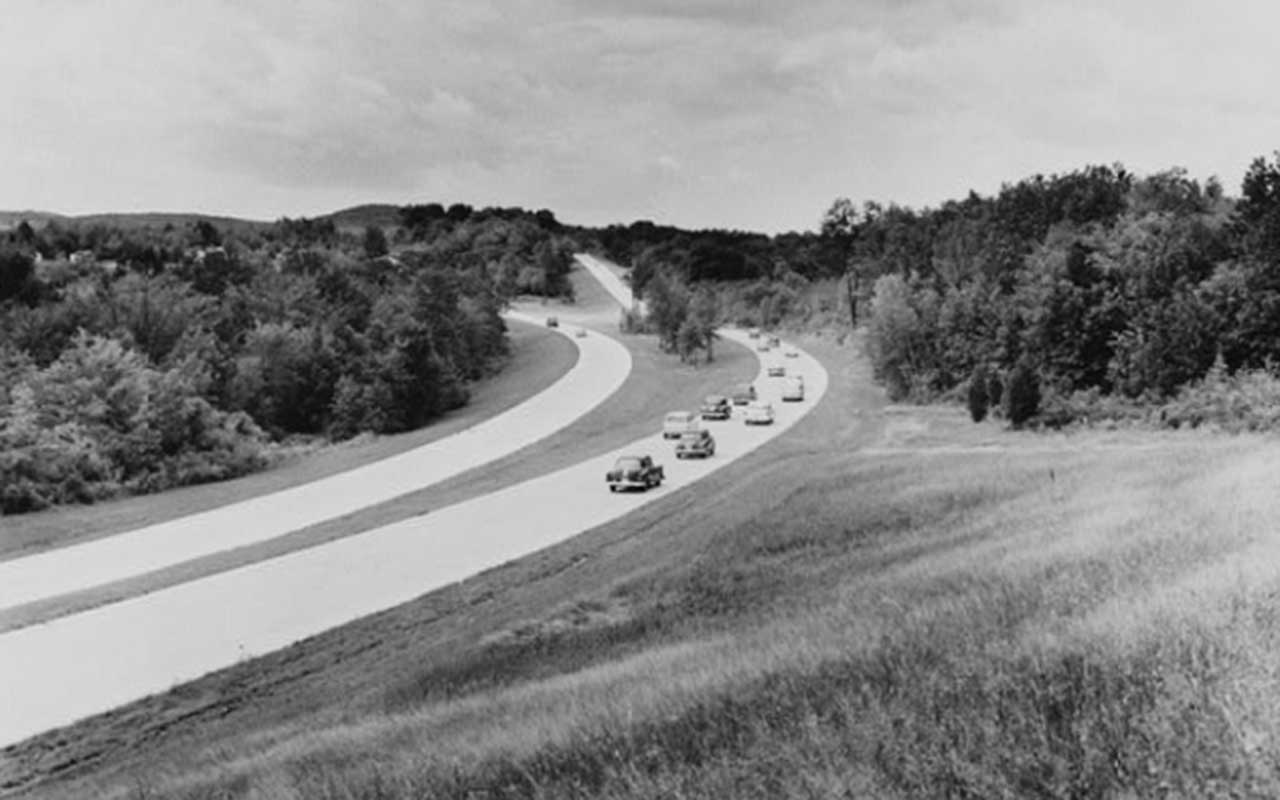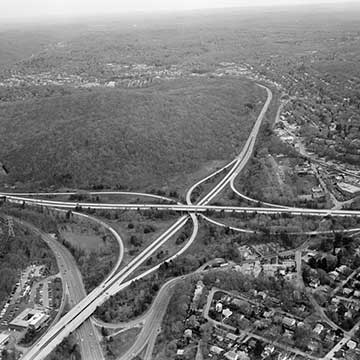This Month’s Featured Article

The Taconic State Parkway
 The Taconic State Parkway never quite got to where it was going.
The Taconic State Parkway never quite got to where it was going.
While some drivers love it and others hate it, at 105.3 miles in length, it is the longest parkway in New York State, we’ll give it that. If there’s anyone here who’s not driven the road, I’m thinking you may want to consider purchasing a lottery ticket tonight, because to have not traveled at least some portion of the TSP – officially designated New York State Route 987G – is nearly impossible when tooling around these parts.
From start to finish
Beginning at the commanding presence of the Kensico Dam/Plaza in Westchester County and terminating in northern Columbia County at Chatham and the Berkshire Spur of the New York State Thruway, the north-south oriented TSP passes through the counties of Westchester (21.6 miles), Putnam (13.5), Dutchess (38.6), and Columbia (31.6).
Its construction was a combined project of the Westchester County Park Commission, the Taconic State Park Commission, and the New York State Department of Public Works.
In 1992, the New York State Legislature designated the TSP a State Scenic Highway, and in 2005, it took its place on the National Register of Historic Places. It has also at least once earned the less-than-coveted tag of New York’s most dangerous highway.
A little historical context
As the automobile began making inroads into American life, future United States President and Hyde Park native Franklin Delano Roosevelt, serving as chairman of the Taconic State Park Commission in the mid-1920s, envisioned would become the TSP: Approximately midway between Albany Post Road and the Harlem River Valley and coming out on the west side of Shenandoah Valley, passing thence east of East Fishkill, east of Hopewell … to Philmont and past Chatham, with the idea that at some point north of Chatham it would be divided so one fork would lead northeast to Williamstown and the Mohawk Trail and the other fork northwest passing east of Troy to the Saratoga Battlefield.
New York City planner Robert Moses was not of the same mind. Sparks flew, as Moses lobbied for a parkway to extend easterly to Jones Beach, and for a spell Moses appeared to gain the upper hand as TSP funding was curtailed. But that didn’t last long. Under the aegis of the Taconic State Park Commission, the design of the TSP fell to the care of the designer of the Bronx River Parkway, landscape architect Gilmore Clarke, charged with developing a route for automobiles that took in views of the Hudson Highlands, Catskills, and Taconic regions.
In the autumn of 1937, unofficial estimates held that the cost of constructing the parkway to Lake Taghkanic would wind up at approximately $5 million. That same year, Paul Winslow, executive director of the Taconic State Park Commission, noted that it was not possible at that time to travel non-stop over parkways from Arthursburg in Dutchess County to the lower end of New York City. “It is obvious that a great amount of traffic is going to roll over the Taconic Parkway in getting to and from New York City,” he said, while urging that this increase in traffic spark some giddy-up in TSP construction and continue the push northward to Columbia County.
From that point, the TSP would require another 26 years to complete, with the last segment – ending in Chatham at the Berkshire Spur of the New York State Thruway – opening in 1963. A planned ribbon cutting would be canceled with the assassination of President John F. Kennedy.
A change of thought and use
By this time, the idea of parkways connecting urban areas with parks and recreation sites, simultaneously following rivers and valley and encompassing regional scenery in order to create a pleasant driving experience, had become passé. “Thruways” and “freeways” and their accompanying increase in speed were quickly becoming the preferred method for getting from one place to the next.
As Casper Gutman would tell Sam Spade in The Maltese Falcon: “These are facts, sir. Not school book history, not Mr. Wells’s history, but history nevertheless.”
Putting the nuts and bolts aside for a bit, let’s wander off and chat about some TSP-related stuff.
“Super-duper roads”
Shortly after joining up with the TSP at the southern end looms the Gate of Heaven Cemetery, where such luminaries as Babe Ruth, Dorothy Kilgallen, Dutch Schultz, Mary Higgins Clark, and – for all we know – Judge Crater and Jimmy Hoffa, are interred. In pre-Internet days, one could spend a good part of the day scouring its 160 acres searching for the Babe’s grave. One could, and one once did. Nowadays, I’d surmise it’d be easy as pie to walk right up to it, given the all-knowledge-all-the-time device in our pockets. But where’s the fun in that?
I’m thinking it was the summer of 1969 when one young fella and his mom and dad were on their way to Shea Stadium for a Cards-Mets doubleheader, when they stopped at an eatin’ joint inside a log cabin-looking building in the vicinity of the Hawthorne Circle, which from 1931-71 connected the Saw Mill Parkway with the TSP. Milling around the cash register at the end of the meal, the young fella took a shine to a colorful display of lollipops that resembled whistles. No doubt figuring a load of ballyard food awaited the young man, mom and dad declined to spring for the lollipop whistle, at which time the gent at the register said, in a wistful tone that even a kid could detect, “Go ahead and take one. We won’t be in business much longer once the circle is gone and traffic doesn’t pass by here.” Oof.
Progress. Or not. “Lovely,” Mrs. Toby Berg of Millbrook would be quoted with blatant disdain on the day the aforementioned new interchange opened in 1971. “The more I see of these super‐duper roads, the less I like them. So we’ll be able to go a little faster. Great big deal. They’ve ruined the landscape.”
Carvel had a dream
Sometime thereafter, along came ice cream tycoon Tom Carvel, who had a dream: He transformed 778 acres adjacent to the TSP off Ferris Lane, Red Hook, into an 18-hole, 7,030-yard championship golf course; a separate nine-hole, par 27 course; tennis courts; a 36-hole putting green; the All-American Collegiate Golf Hall of Fame; three swimming pools; stables with rental horses; a skeet-shooting range; hiking trails; and a toboggan run, all of which would be known as the All American Sports City, Inc.
Among Carvel’s associates in this doomed endeavor were Bob Hope, Arnold Palmer, Perry Como, Sammy Kaye, and Chris Schenkel with Vic Damon serving as vice-president of the complex. In 1974, the New York State high school golf championship was held on the course, and in 1975 and ’76, the LPGA would conduct what was known as the Girl Talk Classic on the All-American Sports City course. In time, it all cratered in rather mind-numbing fashion, and with it plans for condos and hotels.
Today, you’d be hard-pressed to detect many signs – other than from miles above on Google Earth – of the golf course that once occupied the site.
UFOs on the TSP
In the early 1980s, UFO sightings sashayed into TSP lore. On separate occasions a retired New York City cop and a Yorktown police officer spotted what was described as a large, V-shaped aircraft approximately the size of a football field and for the most part, in no particular hurry, at least until it suddenly had enough and zipped away. A white light was said to emanate from the thing. Shortly thereafter, it was observed lingering over the TSP, with drivers stopping to have a look and causing a miles-long traffic backup. Eventually, thousands would report a sighting.
In 1984, officials told The New York Times that it was a “cleverly executed hoax … formed by five to six pilots flying in tight formation.” Hogwash, said one pilot, who had experience flying in tight formations in jets and who had himself observed the mystery craft. Along came the Unsolved Mysteries TV show in 1992 asking pilots who claimed responsibility for whatever it was to duplicate their results, but when challenged by host Robert Stack, they vanished quicker than the UFO.
Meanwhile, back at the oasis.
“I have to go pee!”
What I’d like to know is where all the rest stops that once dotted the TSP went and why. As a kid, I thought all the stops along the way were pretty snazzy. Could be they had lollipop whistles, for all I can recall. But then they started knocking them down and, in what seemed an odd twist on a rather heavily traveled road offering no end of potential challenges, particularly at the southern end where things can get a bit white-knuckled and otherwise not for the faint of heart, turned one at Todd Hill in Poughkeepsie into a Taste NY store that, among its wonderful array of New York-produced agricultural products, peddles adult beverages. Hmmm. Drink responsibly!
For those inclined to wallow in some serious minutiae, I’d suggest a visit to dot.ny.gov/display/programs/scenic-byways/taconic-pkwy, where the TSP Corridor Management Plan, all 263 pages, awaits.
The last stretch
In 1958, the state opened an eight-mile length of the TSP from Route 82 in West Taghkanic to Route 23 at Martindale. Four years later, bids opened on the construction of the next 11.95 miles, to Route 203 in Chatham. Subsequently, four additional miles were tacked on, bringing the TSP to its terminus at the Berkshire Spur. Despite the years of hue and cry calling for the parkway to be extended into Rensselaer and Berkshire Counties and ultimately to the Canadian border, that was all she wrote. •
Sources:
New York State Department of Transportation, Library of Congress, The Chatham Courier, Pawling-Patterson News Chronicle, The New York Times, The Times Record, Albany Times-Union, The Register Herald, U.S. Department of the Interior, Plane & Pilot Magazine



